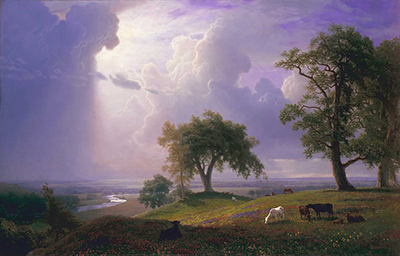Albert Bierstadt completed this oil painting in 1872. This was just after the American Civil War had ended. Therefore, it would have been a time when Americans were eager for images depicting the west and its outstanding natural beauty.
The California Spring painting has been featured at many exhibitions. After its completion, the painting was first exhibited at the Fine Arts Building, New Orleans by Durand, Stokes & Co. Later, it became exhibited at the National Academy of Design which awarded the piece an honourable mention. It is currently on display at the de Young and Legion of Honour Museums of San Fransisco. CA. It has been featured prominently in exhibits about Albert Bierstadt and is one of the most well-known landscape paintings in America.
The painting depicts a scene of a stream in the Sierras with falls and rocky outcrops. The painting illustrates the natural beauty that the Pacific coast offers while also hinting at man's impact on it. Bierstadt worked throughout America using his talents to document American scenery. Viewers can also see lush pines and redwoods surrounding a meadow that is filled with sunshine. A herd of deer peacefully grazes in the background while two horses graze under the shade of some trees behind them.
A large pine is shown in the foreground, and two men are visible fishing at its base. A man on horseback is just visible behind the leftmost rock formation in the background. The painting is very true to nature and was painted after the artist had spent time in the area in 1864, seeking inspiration in the Sierras. The painting was also likely painted in New York City after Bierstadt returned to California with Jay Gould.
According to analysts, the landscape depicted in "California Spring" is a mountainous area with a river. There are several animals and humans seen in the painting, creating a sense of life and activity. Most people see "California Spring" as a symbolic representation of California's increasing draw for settlers. The river is paralleled by a train line that has increased exponentially since discovering gold in 1848; within six months, all passengers had to charter their transportation through the Central Pacific Railroad.
The brushwork used in this painting is loose and expressive, showing the landscape with streaks of colour instead of using solid lines or outlines. Many artists adopted the style around the time Bierstadt began his career, known as Hudson River School. This school is most notably characterised by its depictions of an area known as the Hudson River Valley. Bierstadt has had a significant impact on artists both past and present. His works were extremely popular to the point where they became widely distributed in America through engravings, lithographs, and cartography. This led to his work being reproduced heavily for nearly 100 years after his death.




